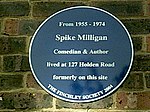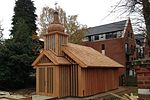Woodside Park tube station
FinchleyFormer Great Northern Railway stationsLondon Underground Night Tube stationsLondon stations without latest usage statistics 1415London stations without latest usage statistics 1516 ... and 10 more
London stations without latest usage statistics 1617London stations without latest usage statistics 1718London stations without latest usage statistics 1819London stations without latest usage statistics 1920London stations without latest usage statistics 2021Northern line stationsRail transport stations in London fare zone 4Railway stations in Great Britain opened in 1872Tube stations in the London Borough of BarnetUse British English from August 2012

Woodside Park is a London Underground station in Woodside Park, north London. The station is on the High Barnet branch of the Northern line, between West Finchley and Totteridge and Whetstone stations, and in Travelcard Zone 4. Woodside Park is the last station in an alphabetical list of London Underground stations.
Excerpt from the Wikipedia article Woodside Park tube station (License: CC BY-SA 3.0, Authors, Images).Woodside Park tube station
Station Approach, London Woodside Park (London Borough of Barnet)
Geographical coordinates (GPS) Address External links Nearby Places Show on map
Geographical coordinates (GPS)
| Latitude | Longitude |
|---|---|
| N 51.618055555556 ° | E -0.18555555555556 ° |
Address
Woodside Park
Station Approach
N12 8SE London, Woodside Park (London Borough of Barnet)
England, United Kingdom
Open on Google Maps








